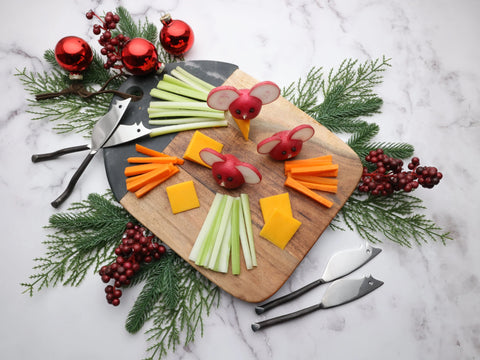The word “cookie” comes from the Dutch word “koek”, which means “little cake”. And while it’s not an unusual tradition, what makes it unique is that the Christmas cookie is a real global story.
Around the world, different cultures have celebrated the changing of the seasons. In the Middle Ages, the European winter solstice festivals began merging with Christmas celebrations. Cookies became popular at this time of year because they were easy to make in large batches and could be stored for long periods.
The grandfather of all cookies, the gingerbread cookie evolved as spices like cinnamon, ginger, and cloves started appearing throughout Europe. Nuremberg, Germany, an intersection of two trading routes is considered the birthplace of the gingerbread biscuit, which is said to have evolved from the spiced honey cakes brought from the Arab world.
From gingerbread to shortbread, making cookies is a holiday tradition we love!

The Night of the Radishes
On December 23, in Oaxaca, Mexico, they have a festival with an unusual activity. At the festival, merchants and artisans sell radishes. Not that unusual, you say? Wait, there’s more! Radishes are carved into various displays, such as nativity scenes, wildlife tableaus, and more. Carving displays are sold to become Christmas centerpieces, with the best radish design winning a prize.
The event began, as the legend goes, when one year the radish crop was so abundant, that a large section was left unharvested for months. When two friars began pulling them up in December, they discovered that the radishes had grown into unusual shapes and sizes. So they brought them to the Christmas market, held on December 23. From there the idea to carve them into figures and shapes was born and in 1897, the mayor decided to create the radish-carving competition, and the event is still held every year.

Enjoy some edible radish carvings with a cheese and crudities snack. The Mesa Marble Wood Cutting Board is the ideal size for a snack for two.
A Christmas Eve tradition in Italy
St. Joseph’s spaghetti or Spaghetti di San Giuseppe, is a special pasta dish, traditionally served on March 19th (the feast day of St. Joseph) and Christmas Eve. The dish honors St. Joseph, the husband of Mary and the earthly father figure of Jesus.
A classic example of “cucina povera” or peasant cooking, this simple but delicious dish is spaghetti, coated with a mixture of olive oil, walnuts, garlic, golden raisins, parsley, and toasted breadcrumbs. (St. Joseph was a carpenter and the toasted breadcrumbs represent sawdust.)
Does the concept of eating this pasta with breadcrumbs sound unappealing? Try this recipe! You’ll be surprised at how the sweet and nutty flavors combine to make this pasta dish special!

12 Grapes on New Year’s Eve
This last unique tradition happens to fall on the last day of the year. This tradition dates back to 1880 in Madrid, Spain. As the legend goes, it all began with a tradition of eating grapes and drinking champagne to celebrate an abundant grape harvest.
Grapes are a symbol of abundance and are associated with bringing blessings. The ritual involves eating 12 grapes (one for each month of the year) at midnight to guarantee a year filled with prosperity, health, and happiness.

While that might sound easy, the trick is to completely consume all 12 grapes by the time the twelve tolls of midnight are complete, seeds and all. Good luck!
Wishing our amazing artisans and customers a peaceful, prosperous, and Happy New Year!
🥂🥂🥂



